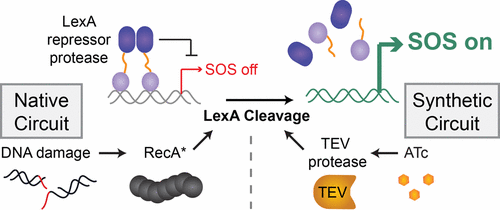当前位置:
X-MOL 学术
›
ACS Synth. Biol.
›
论文详情
Our official English website, www.x-mol.net, welcomes your
feedback! (Note: you will need to create a separate account there.)
A Small-Molecule Inducible Synthetic Circuit for Control of the SOS Gene Network without DNA Damage
ACS Synthetic Biology ( IF 3.7 ) Pub Date : 2017-09-01 00:00:00 , DOI: 10.1021/acssynbio.7b00108 Jeffrey M. Kubiak 1 , Matthew J. Culyba 1 , Monica Yun Liu 1 , Charlie Y. Mo 1 , Mark Goulian 2 , Rahul M. Kohli 1
ACS Synthetic Biology ( IF 3.7 ) Pub Date : 2017-09-01 00:00:00 , DOI: 10.1021/acssynbio.7b00108 Jeffrey M. Kubiak 1 , Matthew J. Culyba 1 , Monica Yun Liu 1 , Charlie Y. Mo 1 , Mark Goulian 2 , Rahul M. Kohli 1
Affiliation

|
The bacterial SOS stress-response pathway is a pro-mutagenic DNA repair system that mediates bacterial survival and adaptation to genotoxic stressors, including antibiotics and UV light. The SOS pathway is composed of a network of genes under the control of the transcriptional repressor, LexA. Activation of the pathway involves linked but distinct events: an initial DNA damage event leads to activation of RecA, which promotes autoproteolysis of LexA, abrogating its repressor function and leading to induction of the SOS gene network. These linked events can each independently contribute to DNA repair and mutagenesis, making it difficult to separate the contributions of the different events to observed phenotypes. We therefore devised a novel synthetic circuit to unlink these events and permit induction of the SOS gene network in the absence of DNA damage or RecA activation via orthogonal cleavage of LexA. Strains engineered with the synthetic SOS circuit demonstrate small-molecule inducible expression of SOS genes as well as the associated resistance to UV light. Exploiting our ability to activate SOS genes independently of upstream events, we further demonstrate that the majority of SOS-mediated mutagenesis on the chromosome does not readily occur with orthogonal pathway induction alone, but instead requires DNA damage. More generally, our approach provides an exemplar for using synthetic circuit design to separate an environmental stressor from its associated stress-response pathway.
中文翻译:

用于控制SOS基因网络而无DNA损伤的小分子诱导合成电路
细菌SOS应激反应途径是一种促突变的DNA修复系统,可介导细菌的存活和对遗传毒性应激源(包括抗生素和紫外线)的适应。SOS途径由在转录阻遏物LexA的控制下的基因网络组成。该途径的激活涉及相互联系但又不同的事件:最初的DNA损伤事件导致RecA激活,从而促进LexA的自蛋白水解,废除其阻遏物功能并导致SOS基因网络的诱导。这些关联的事件可以各自独立地促进DNA修复和诱变,从而难以区分不同事件对观察到的表型的贡献。通过LexA的正交切割。用合成的SOS电路工程化的菌株证明了SOS基因的小分子诱导表达以及对紫外线的抵抗力。利用我们独立于上游事件而激活SOS基因的能力,我们进一步证明,仅靠正交途径诱导并不容易发生大多数SOS介导的染色体诱变,而是需要DNA损伤。更一般而言,我们的方法提供了使用合成电路设计将环境压力源与其关联的压力响应路径分开的示例。
更新日期:2017-09-04
中文翻译:

用于控制SOS基因网络而无DNA损伤的小分子诱导合成电路
细菌SOS应激反应途径是一种促突变的DNA修复系统,可介导细菌的存活和对遗传毒性应激源(包括抗生素和紫外线)的适应。SOS途径由在转录阻遏物LexA的控制下的基因网络组成。该途径的激活涉及相互联系但又不同的事件:最初的DNA损伤事件导致RecA激活,从而促进LexA的自蛋白水解,废除其阻遏物功能并导致SOS基因网络的诱导。这些关联的事件可以各自独立地促进DNA修复和诱变,从而难以区分不同事件对观察到的表型的贡献。通过LexA的正交切割。用合成的SOS电路工程化的菌株证明了SOS基因的小分子诱导表达以及对紫外线的抵抗力。利用我们独立于上游事件而激活SOS基因的能力,我们进一步证明,仅靠正交途径诱导并不容易发生大多数SOS介导的染色体诱变,而是需要DNA损伤。更一般而言,我们的方法提供了使用合成电路设计将环境压力源与其关联的压力响应路径分开的示例。









































 京公网安备 11010802027423号
京公网安备 11010802027423号